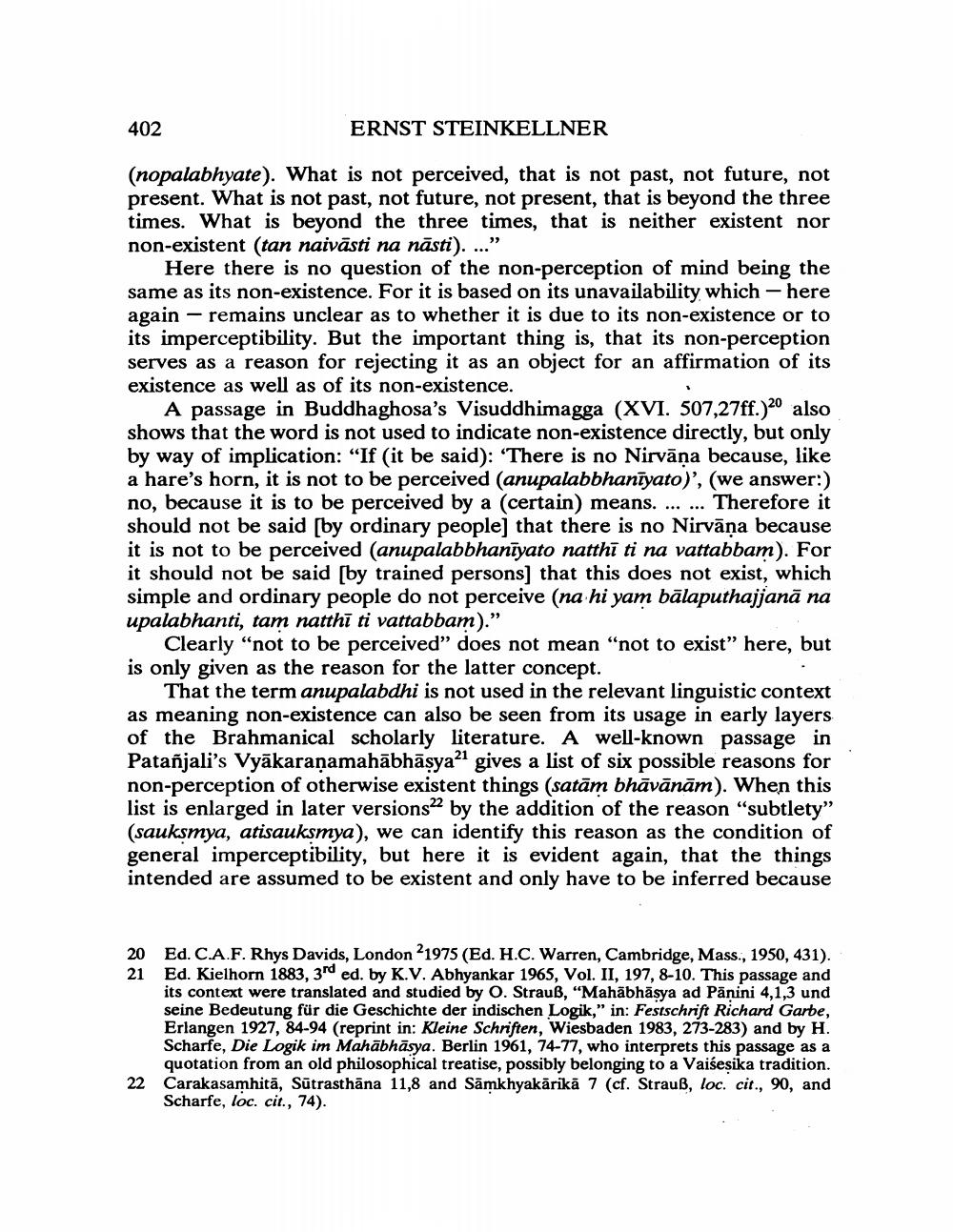Book Title: Lamotte And Concept Of Anupalabdhi Author(s): Ernst Steinkellner Publisher: Ernst Steinkellner View full book textPage 5
________________ 402 ERNST STEINKELLNER (nopalabhyate). What is not perceived, that is not past, not future, not present. What is not past, not future, not present, that is beyond the three times. What is beyond the three times, that is neither existent nor non-existent (tan naivāsti na nāsti). ..." Here there is no question of the non-perception of mind being the same as its non-existence. For it is based on its unavailability which - here again – remains unclear as to whether it is due to its non-existence or to its imperceptibility. But the important thing is, that its non-perception serves as a reason for rejecting it as an object for an affirmation of its existence as well as of its non-existence. A passage in Buddhaghosa's Visuddhimagga (XVI. 507,27ff.)20 also shows that the word is not used to indicate non-existence directly, but only by way of implication: "If (it be said): 'There is no Nirvāna because, like a hare's horn, it is not to be perceived (anupalabbhanīyato)', (we answer:) no, because it is to be perceived by a certain) means. ... ... Therefore it should not be said [by ordinary people that there is no Nirvāņa because it is not to be perceived (anupalabbhanīyato natthi ti na vattabbam). For it should not be said [by trained persons) that this does not exist, which simple and ordinary people do not perceive (na hi yam bālaputhajjanā na upalabhanti, tam natthī ti vattabbam)." Clearly "not to be perceived” does not mean "not to exist” here, but is only given as the reason for the latter concept. That the term anupalabdhi is not used in the relevant linguistic context as meaning non-existence can also be seen from its usage in early layers of the Brahmanical scholarly literature. A well-known passage in Patañjali's Vyākaranamahābhāsya? gives a list of six possible reasons for non-perception of otherwise existent things (satām bhāvānām). When this list is enlarged in later versions by the addition of the reason “subtlety" (sauksmya, atisauksmya), we can identify this reason as the condition of general imperceptibility, but here it is evident again, that the things intended are assumed to be existent and only have to be inferred because 20 21 Ed. C.A.F. Rhys Davids, London 21975 (Ed. H.C. Warren, Cambridge, Mass., 1950, 431). Ed. Kielhorn 1883, 3rd ed. by K.V. Abhyankar 1965, Vol. II, 197, 8-10. This passage and its context were translated and studied by O. Strauß, "Mahābhāsya ad Pānini 4,1,3 und seine Bedeutung für die Geschichte der indischen Logik," in: Festschrift Richard Garbe, Erlangen 1927, 84-94 (reprint in: Kleine Schriften, Wiesbaden 1983, 273-283) and by H. Scharfe, Die Logik im Mahābhāsya. Berlin 1961, 74-77, who interprets this passage as a quotation from an old philosophical treatise, possibly belonging to a Vaiśesika tradition. Carakasamhitā, Sūtrasthāna 11,8 and Samkhyakārikā 7 (cf. Strauß, loc. cit., 90, and Scharfe, loc. cit., 74). 22Page Navigation
1 ... 3 4 5 6 7 8 9 10 11 12 13
